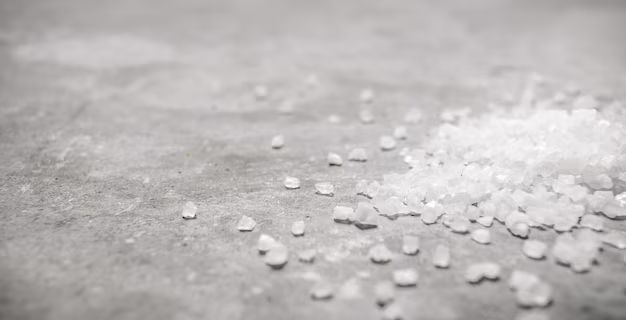Using rock salt on concrete surfaces is a common practice in colder climates to melt ice and snow. However, this can potentially damage concrete over time. Here is a closer look at the effects of rock salt on concrete and whether it’s OK to use.
Page Contents
What is Rock Salt?
Rock salt, also known as halite, is mined from ancient seabeds and is mostly composed of the mineral sodium chloride (NaCl). It appears as a white or light gray crystalline structure. Rock salt is used for a variety of purposes, including food processing, water conditioning, manufacturing, agriculture, and keeping roads and sidewalks clear of snow and ice.
When rock salt comes into contact with snow and ice, it lowers the freezing point, causing the snow and ice to melt. This makes it an effective and inexpensive deicing agent. However, using rock salt does have some drawbacks.
Does Rock Salt Damage Concrete?
Yes, rock salt can potentially damage concrete surfaces over time when used as a deicer. Here are some of the ways rock salt impacts concrete:
- Corrosion of rebar – Concrete contains steel reinforcement bars called rebar. Salt speeds up corrosion of these metal bars as it breaks down and penetrates the concrete.
- Surface scaling – Salt reacts with concrete and causes the surface to flake off and scale.
- Loss of strength – As salt permeates into concrete, it damages the internal structure, leading to loss of strength and durability.
- Cracking – The freezing and thawing cycles caused by melting and refreezing rock salt can cause cracks in concrete.
- Spalling – Corrosion of rebar leads to expansion inside the concrete, causing chunks or flakes to break loose.
- Staining – Rock salt leaves behind white stains on concrete surfaces as residue builds up over time.
Factors That Increase Concrete Damage
Certain factors can make concrete more vulnerable to the damaging effects of rock salt:
- Age – New concrete is more resistant while older, more porous concrete is more susceptible to salt penetration.
- Quality – Poor quality concrete with low strength is more prone to salt damage.
- Environment – Concrete in cold climates that go through regular freeze-thaw cycles deteriorates faster.
- Drainage – Salt will penetrate deeper into concrete where water doesn’t properly drain away.
- Application – Frequent and heavy application of rock salt magnifies its effects on concrete.
Ways to Reduce Concrete Damage
If you need to use rock salt on concrete, here are some ways to minimize damage:
- Limit usage – Only apply light amounts of salt to melt ice. Excess salt gets tracked inside and causes more damage.
- Rinse away – Wash off salt residue when possible to prevent it from accumulating.
- Buy concrete-safe products – Opt for magnesium chloride or calcium chloride deicers formulated to be less corrosive.
- Seal the concrete – Applying sealers minimizes salt penetration into concrete.
- Repair cracks – Fixing cracks right away prevents salt seeping in and making cracks expand.
Long-Term Effects of Rock Salt on Concrete
Continued heavy use of rock salt as a deicer will damage concrete over time. Here are the long-term effects:
- It becomes stained, scaled, and pitted.
- The surface starts to flake off and erode.
- Cracks form and continue to expand.
- It develops major pitting, pop-outs, and voids.
- The internal steel rebar corrodes and rusts.
- It loses significant strength and durability.
- It requires extensive and costly repairs.
Heavily salt-damaged concrete may need to be replaced completely if deterioration is too advanced. Even repaired concrete can be prone to faster degradation later on.
Alternative Deicers That Are Safer for Concrete
To minimize adverse effects on concrete, consider using alternate deicers and ice melting products such as:
- Calcium chloride – Less damaging since it doesn’t contain sodium.
- Magnesium chloride – Prevents leaching and scaling on concrete.
- Potassium chloride – A reduced corrosivity formula.
- Calcium magnesium acetate (CMA) – Biodegradable and minimally corrosive.
- Urea – A fertilizer that is less likely to damage concrete.
- Sand or ash – Provides traction without corroding concrete.
While most deicers can still degrade concrete over time, these alternatives work slower and cause less damage compared to sodium chloride rock salt.
Is it Ever OK to Use Rock Salt on Concrete?
Using rock salt occasionally or in small amounts on residential concrete likely causes minimal damage. However, regular heavy application year after year for commercial properties can ruin concrete surfaces.
Here are some good guidelines on using rock salt on concrete:
- Avoid it on decorative stamped or exposed aggregate concrete.
- Only use it lightly on residential driveways and patios.
- Do not use it at all on garage floors or indoor entryways.
- Rinse it away as soon as ice melts.
- For commercial use, opt for concrete-safe salts or alternatives.
- Repair cracks and stains on concrete right away.
With judicious use, you can melt snow and ice on concrete when needed while minimizing long-term damage. But it’s best to explore safer concrete-friendly deicers whenever possible.
Conclusion
Rock salt is effective for melting snow and ice, but it can damage concrete surfaces over time. Regular heavy use causes corrosion, scaling, cracking, and strength loss. Limiting application, prompt cleanup, concrete sealers, and safer deicer alternatives can help reduce the risks. For high-traffic commercial concrete, sodium chloride salt products should be avoided if possible to prevent premature deterioration.
